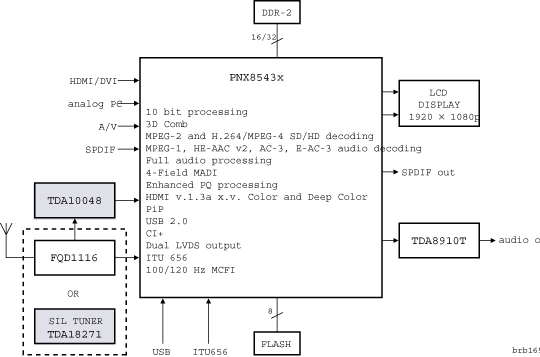

MPEG-4/H.264 LCD TV solution T
IC应用电路图
描述
General description
Featuring an integrated MPEG-4/H.264 decoder, the TV543 single chip LCD TV solution enables consumers to access more video content directly on their TVs while maintaining the best possible picture quality.
Blockdiagrams

Meeting all industry standards for worldwide LCD TV reception, the TV543 supports inputs from analog to digital, SD to HD, broadcast to networked (IPTV, internet, VOD). The first LCD TV solution to feature an integrated MPEG-4/H.264 decoder, it enables the reception and decoding of MPEG-2 and MPEG-4/H.264 SD and HD content.
It is also the first DTV platform to integrate CI+ conditional access, ensuring the best possible protection of content against unauthorized copying. This has the additional benefit for consumers that set-top boxes or PCs are no longer required in the living room.
PNX8543x
The TV543 is based around the Nexperia PNX8543x Home Entertainment Engine which features a MIPS 4KEc and a Trimedia AV DSP, both running at 300 MHz. In addition to the integrated MPEG-2/MPEG-4/H.264 video decoder this IC supports MPEG1, HE-AAC v2 and/or Dolby Digital (Plus) audio decoding. Input is via two integrated HDMI ports. An integrated USB 2.0 host controller is available for media browsing from flash memory or external hard drives. The chips feature integrated dual LVDS outputs and can support 100/120 Hz LCD panels via MCFI.
The reference design also features a choice of ATSC or DVB front-ends based on our proven can or silicon tuners and single-chip channel decoders. And for high-end TV designs, our PNX5100 companion chip provides additional picture quality improvements to assure the best possible picture quality.
TV543 software
The TV543 comes complete with a set of drivers that offers a low level abstraction of the underlying hardware allowing setmakers to port their own middleware and applications. The drivers allow OEMs to define view modes, picture styles, sound styles, tuning algorithms and more.
-
H.264编码原理2022-08-31 855
-
H.264和MPEG-4优劣势对比分析哪个好?2021-04-20 3772
-
H.264(MPEG)-4AVC2019-11-20 2449
-
是否DM368 HDVICP只能处理MPEG-4而不能处理H.264?2019-02-12 1926
-
什么是AVC编码? 简述H.264概念和发展2018-12-25 2866
-
H.264视频编码算法的认识与理解2017-12-01 5047
-
H.264与MPEG-4压缩编码标准的分析与比较2011-09-02 1288
-
基于H.264解码器的软件优化2010-10-18 1367
-
MPEG-4/H.264 LCD TV solution TV5432008-09-25 4941
-
H.264/MPEG-4研究组织和人员荣获科技类艾美奖2008-08-28 929
-
H.264 MPEG-4 White Paper2008-06-25 7150
-
视频压缩标准MPEG-4和H.264的基础知识2008-05-28 6575
-
H.264是什么?H.264标准详解2007-11-07 1870
全部0条评论

快来发表一下你的评论吧 !

